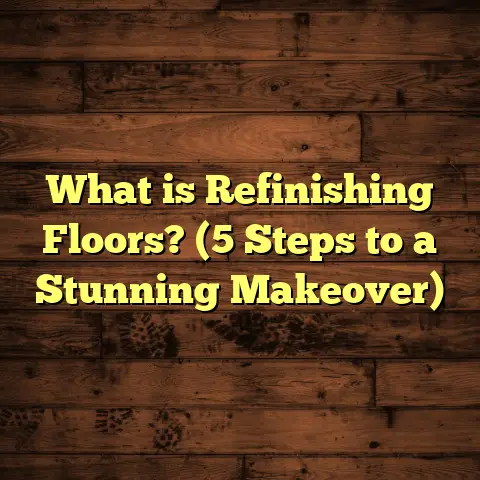What is Standard Underlayment for Tile on Wood Floors? (5 Tips to Choose the Best!)
Have you ever finished laying tiles over a wood floor only to notice cracks forming or tiles popping loose after a few months? I’ve been in that frustrating spot more than once. You put in the effort, spend the money, and then—bam—the floor starts to fail. One of the biggest reasons this happens is because of what lies beneath the tile—the underlayment. If your underlayment isn’t up to the task, your tile floor won’t last. So, what exactly is standard underlayment for tile on wood floors? And how do you pick the best one for your project? Let’s chat about it.
What is Standard Underlayment for Tile on Wood Floors?
At its simplest, underlayment is the layer between your wood subfloor and the tile. You might think tile can just go directly onto wood, but that’s usually a recipe for disaster. Wood naturally moves—it expands and contracts with temperature and humidity changes. Tile, on the other hand, is rigid and doesn’t tolerate movement well. Without a proper buffer between them, you end up with cracks and grout failure.
Standard underlayment for tile on wood floors typically involves materials designed to provide a stable, moisture-resistant, and crack-preventing base for tile installation. The most common types are cement backer boards (like HardieBacker or Durock) and uncoupling membrane systems (such as Schluter Ditra). Both serve to protect the tile from subfloor movement and moisture but do so in different ways.
I recall one of my early jobs where a homeowner didn’t use any underlayment over an existing wood floor. The tiles looked great initially but started cracking within six months. After removing the tile, I discovered the wood subfloor flexed too much with every step, causing stress on the brittle tile above. We ended up installing cement backer board during the redo, and that floor has been rock solid ever since.
Why Is Underlayment So Important for Tile Over Wood Floors?
Wood floors are inherently flexible compared to concrete slabs. Even sturdy plywood or OSB will bend slightly under weight or environmental changes. Tile needs a rigid foundation to prevent cracking. Underlayment acts as a decoupling layer—it isolates the tile from movement in the wood below.
Additionally, wood can absorb moisture from spills or humidity, which can cause swelling and warping. Moisture can also damage tile adhesives and grout if it seeps through. Underlayments can provide some moisture protection to prevent these issues.
Without proper underlayment, you risk:
- Cracks in tiles and grout
- Loose or hollow-sounding tiles
- Mold or mildew from moisture trapped beneath
- Premature tile failure and costly repairs
I’ve often emphasized to clients that underlayment isn’t just optional padding—it’s a critical part of making tile stick and last.
Understanding Your Wood Subfloor: The Foundation of Your Project
When choosing an underlayment, the first thing I always check is the condition of the wood subfloor itself. Not all wood floors are created equal.
Subfloor Material: Plywood vs OSB
Plywood is made of thin layers of wood veneer glued together with alternating grain directions. It tends to be stronger and more stable than OSB (oriented strand board), which is made from compressed wood strands.
Plywood subfloors generally provide better support for tile but can still flex if too thin. OSB can be acceptable if it’s thick enough (usually 3/4 inch minimum) and in good condition but is more susceptible to moisture damage.
On one project, I found an older home with 1/2-inch OSB subflooring that had minor water damage near a bathroom. Installing tile directly over it would have been a bad idea. We replaced sections with new plywood and reinforced joists before proceeding.
Thickness Matters
Most tile manufacturers recommend a minimum subfloor thickness of 3/4 inch for direct tile installation with proper underlayment. Thinner subfloors tend to flex more, increasing the risk of cracked tiles.
If your subfloor is thinner than 3/4 inch, adding an extra layer of plywood or cement board can stiffen it up. I once had to add a second 1/2-inch plywood layer over an old floor to reduce bounce before installing backer board and tile.
Level and Clean Surface
The underlayment installation requires a flat surface to adhere properly. Any dips or bumps will telegraph through to your tile surface later on.
Before installing underlayment, I always check for uneven spots using a straightedge or level. Low spots can be patched with leveling compound, while high spots may need sanding or removal.
Cleaning debris, nails, or staples is also important as these can interfere with proper adhesion or screw placement.
Types of Standard Underlayments for Tile on Wood Floors
There are several options when it comes to underlayment for tile on wood floors. Each has pros and cons depending on your project needs.
Cement Backer Board
Cement backer board has long been considered the gold standard for tile underlayment over wood floors. It consists of cement mixed with reinforcing fibers formed into panels typically 1/4 inch thick.
Advantages:
- Provides a rigid, stable surface for tile
- Moisture resistant and won’t rot or swell
- Compatible with most thinset mortars and tiles
- Relatively affordable material cost
Installation: You apply a layer of thinset mortar over your clean wood subfloor, then place and screw down the backer board into the wood below. Joints are taped and thinset applied over seams before tiling.
Drawbacks: It adds weight and height to your floor by about 1/4 inch, which can affect door clearances. Cutting boards requires special tools or blades. Installation can be labor-intensive.
I’ve used cement backer board extensively on ground floors or where maximum rigidity was needed—like kitchens or entryways with heavy foot traffic.
Uncoupling Membranes (e.g., Schluter Ditra)
Uncoupling membranes are polyethylene grid mats designed to separate tile from subfloor movement by absorbing stress.
Advantages:
- Excellent crack isolation preventing subfloor movement from transferring to tile
- Provides waterproofing benefits when installed correctly
- Lightweight and thin (adds about 1/8 inch thickness)
- Easier installation without screws; adheres with thinset
Installation: Spread thinset mortar on the subfloor then roll out the membrane and embed it into the mortar with a trowel notch. Tiles are then installed directly over the membrane using thinset.
Drawbacks: Higher material cost than cement boards. Requires precise installation to ensure full adhesion.
For upper floors prone to flexing, I often recommend membranes like Ditra because they’re very effective at stopping cracks from developing due to movement below.
Fiber Cement Boards
These are similar to cement backer boards but often lighter and sometimes easier to cut. They also provide moisture resistance and stability but might not be as rigid as traditional cement boards.
Plywood Overlays
Some installers add an extra layer of plywood before applying backer board or membranes for additional stability. However, plywood alone isn’t recommended as a final underlayment for tile because it doesn’t protect against moisture or flexing enough.
How Moisture Impacts Your Underlayment Choice
Moisture is one of the biggest enemies of both wood floors and tile installations. Water intrusion can cause wood subfloors to swell, warp, or rot—and it can weaken tile adhesive bonds leading to failures.
If your project is in a high-moisture environment like bathrooms or kitchens, selecting an underlayment with waterproofing properties is wise.
Waterproof Membranes vs Cement Boards
Cement backer boards themselves don’t waterproof—they resist moisture but allow water vapor through unless sealed with membranes or coatings.
Products like Schluter Ditra offer built-in waterproofing when paired with appropriate sealing at seams and edges. This reduces water penetration into wood below significantly.
On one bathroom remodel I did, we combined Ditra membrane with waterproofing sealant around the tub area. After several years, no signs of moisture damage appeared underneath despite occasional water spills.
Installation Tips Based on My Experience
Choosing the right underlayment is just part of the equation—proper installation matters just as much.
Use Thinset Mortar Properly
Thinset mortar acts as both an adhesive and leveling agent between your subfloor and underlayment. Applying it evenly ensures full contact and support.
A common mistake I’ve seen is “spotting” thinset instead of spreading it fully across the surface. This creates voids where tiles can flex leading to cracks.
Screw Down Cement Boards Correctly
When using cement backer boards, make sure screws are corrosion-resistant (like coated deck screws) and placed according to manufacturer guidelines—typically every 6 inches along edges and every 8 inches in field areas.
Avoid countersinking screws too deeply or leaving them proud above the surface as this can cause unevenness.
Tape Joints Thoroughly
Taping joints between backer boards with fiberglass mesh tape embedded in thinset strengthens seams and prevents cracks from telegraphing through tiles.
Allow Drying Time
Don’t rush tiling after installing underlayment—allow adequate drying time for thinset mortar based on product instructions to avoid adhesion problems.
Inspect Subfloor Deflection
Before any work begins, check floor deflection (how much it bends). Many building codes suggest floors should not deflect more than L/360 (where L = span length in inches) for tile installations.
If your floor deflects too much, adding reinforcement like sister joists or additional plywood layers may be necessary before underlayment installation.
Comparing Costs: Cement Board vs Membrane Underlayments
Cost often drives decisions about flooring materials. Here’s what I’ve found based on multiple projects:
| Item | Average Cost per Sq Ft (Material + Labor) | Notes |
|---|---|---|
| Cement Backer Board | $5 – $7 | Includes thinset, screws; labor-intensive |
| Uncoupling Membrane (Ditra) | $7 – $9 | Higher material cost; faster installation |
| Plywood Overlay | $3 – $5 | Usually combined with other layers |
Using FloorTally has helped me estimate these costs accurately by factoring local prices and labor rates. This transparency helps clients make informed choices balancing budget with performance expectations.
Case Study: Tile Installation Over Wood Floor Using Different Underlayments
I want to share a detailed example from my own work comparing two projects:
Project A: Cement Backer Board Installation Over Ground Floor Kitchen
- Subfloor: 3/4 inch plywood
- Underlayment: HardieBacker cement board
- Tile: Porcelain 12×24 inch
- Installation time: 3 days
- Cost per sq ft: $6.50
- Outcome after 3 years: Zero cracks; very solid floor
- Client feedback: Very satisfied; no maintenance issues
Project B: Schluter Ditra Membrane Over Second Story Bathroom
- Subfloor: 3/4 inch plywood
- Underlayment: Schluter Ditra membrane
- Tile: Ceramic 8×8 inch
- Installation time: 2 days
- Cost per sq ft: $8.50
- Outcome after 3 years: No cracks; no moisture issues despite bathroom use
- Client feedback: Appreciated minimal floor height increase; smooth finish
This comparison shows how both options perform well when installed correctly but differ in cost, installation time, and application suitability.
What About Other Flooring Types?
You might wonder how standard tile underlayments stack up against those used for laminate, hardwood, or vinyl floors installed over wood subfloors.
- Laminate Flooring: Uses foam or cork underlayments primarily for sound absorption—not suitable for tile because they compress.
- Hardwood Flooring: Often installed directly over plywood with a moisture barrier; no rigid underlayment needed since wood tolerates some flexing.
- Vinyl Flooring: May use thin foam underlayments or be glued directly; again no rigid support needed like tile requires.
Tile demands rigidity combined with moisture protection—which standard cement boards or membrane systems provide best over flexible wood floors.
My Top 5 Tips To Choose Best Underlayment For Tile On Wood Floors
- Check Subfloor Thickness & Condition
If your wood floor feels bouncy or is thinner than 3/4 inch plywood, plan reinforcement first. - Select Between Cement Backer Board or Membrane Based On Location
Cement board suits ground floors; membranes shine on upper floors needing crack isolation. - Consider Moisture Exposure
Bathrooms/wet areas benefit from waterproof membranes. - Factor In Floor Height Changes & Door Clearances
Membranes add less height than cement boards—important in tight spaces. - Assess Your Skill Level & Tools Available
Membranes are easier for DIYers; cement board installation benefits from professional experience.
Wrapping It Up With A Comparison And What Works Best When
Choosing standard underlayment comes down to understanding your project specifics:
| Feature | Cement Backer Board | Uncoupling Membrane (Ditra) |
|---|---|---|
| Rigidity | High | Moderate |
| Moisture Resistance | Water-resistant but not waterproof | Waterproof when installed properly |
| Installation Complexity | Moderate to Difficult | Easier |
| Floor Height Added | ~1/4 inch | ~1/8 inch |
| Cost | Lower material cost | Higher material cost |
| Ideal Usage | Ground floor, heavy traffic | Upper floors, bathrooms |
Through years of experience installing hundreds of floors, I’ve found no one-size-fits-all solution—but understanding these differences helps you pick right for your space.
If you want ultimate durability in high-traffic kitchens or entryways, cement backer board still rules. For upper story bathrooms where flexibility and moisture protection matter most, membranes like Ditra offer peace of mind with easier installation.
Whatever you choose, don’t skip this step—it’s what keeps your beautiful tile floor looking great for years without costly fixes.
Have you tackled tiling over wood floors? What kind of underlayment worked best for you? Maybe you ran into tile cracking issues? Feel free to share—I’m always happy to swap stories and tips!





